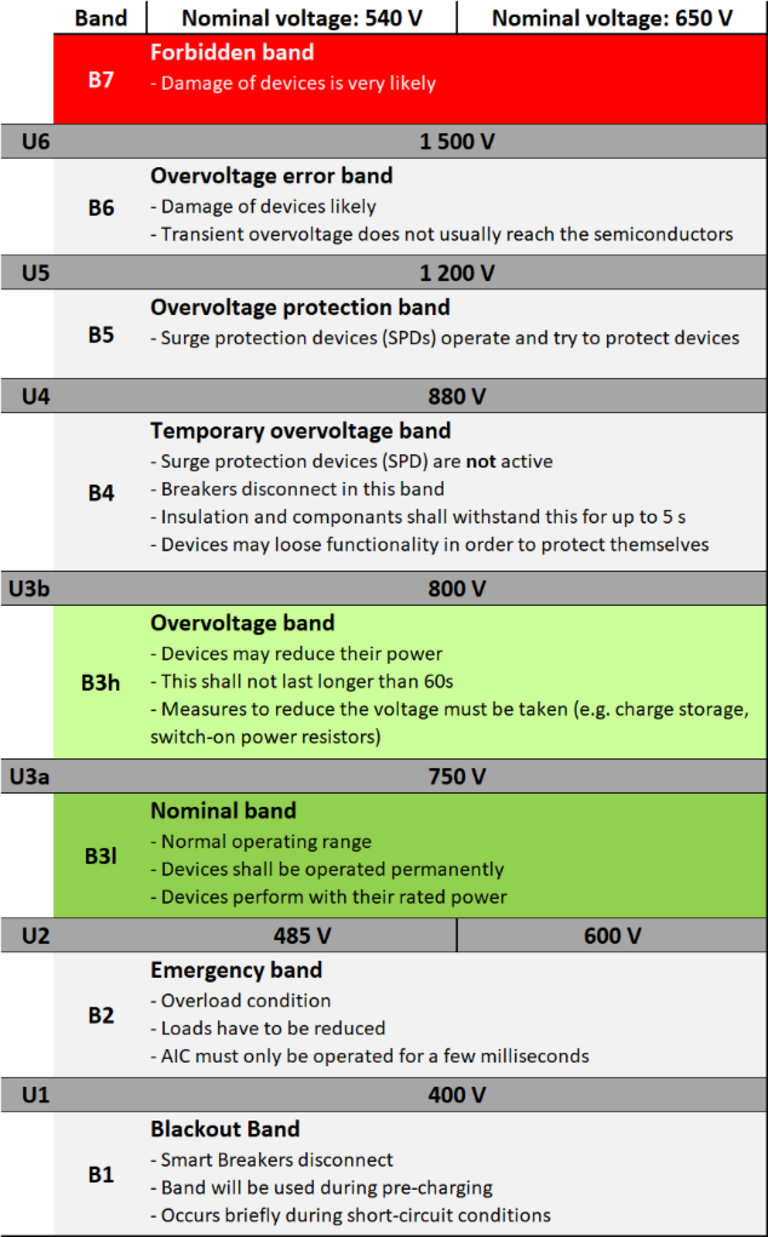3 What are voltage bands?
Voltage bands are predefined voltage ranges in which the components of a DC network provide different functionality. The IEC technical report 63282 has defined 7 bands. Each band Bx is defined by an upper voltage limit Ux. In the nominal band from 600 V to 750 V (for controlled infeed, AIC), the components operate continuously.

3.1 What is the Blackout band B1?
The applications do not work in this band below voltage U1 = 400 V. Therefore, except for pre-charging, the DC grid is only in this range for a short time (e.g. in the event of short circuits). When the voltage drops below U1, the Smart Breakers open.
3.2 What is the Emergency Band B2?
Voltages between 400 V and 485 V (for uncon-trolled rectifiers on 400 V AC) resp. between 400 V and 600 V (for AIC and for uncontrolled rectifiers on 480 V AC).
This band is characterized by a large overload. It is imperative that the load is reduced so that the DC grid does not change to band B1. Devices are allowed to reduce their power. Due to the DC voltage being too low, AICs may only be operated here for a few milliseconds.
3.3 What is the nominal band B3l?
- 600 V to 750 V (AIC or uncontrolled rectifiers on 480 V AC)
- 485 V to 750 V (uncontrolled rectifiers on 400 V AC)
This is the normal operating range of the DC grid. It is characterized by a power balance between local generation (e.g. from PV systems), feed-in from the AC grid and consumption of the loads. All equipment in the grid is designed to operate continuously in this range. Limitations of the device performance can result from physical boundary conditions, such as the state of charge of storage devices, the level of the mains voltage for supply devices, insufficient motor voltage or the solar irradiation for photo voltaic.
3.4 What is the overvoltage band B3h?
Voltages between 750 V and 800 V.
In this band, measures must be taken to prevent the shutdown threshold of the devices (800 V) from being reached. This can be done by feeding back into the AC grid, charging of energy storage devices but also switching-on power resistors. This state should not last longer than 60 s and devices may reduce their power in this state. This band is not yet included in TR 63282.
3.5 What is the temporary overvoltage band B4?
Voltages between 800 V and 880 V.
Overvoltage can occur due to switching operations, faults and braking of drives. A temporary overvoltage of up to 880 V for one minute is not problematic for common 400 V electrolytic capacitors (two in series). In the case of commonly used 1200 V semiconductors, however, the limit of voltage resistance may be reached by internal switching actions; such devices may lose their function in this range in order to protect themselves. Overvoltage protection devices (SPDs) do not yet limit the voltage in this band. If the voltage is in this range for a longer time (> 5 s) the upstream Smart Breaker opens to protect all devices.
3.6 What is the overvoltage protection band B5?
Voltages between 880 V and 1200 V.
In this area, the surge protection devices (SPDs) operate and try to protect devices from transient overvoltage caused by switching operations but also lightning strikes.
3.7 What is the overvoltage error band B6?
Voltages between 1200 V and 1500 V.
If the voltage is in this band, damage to the equipment is likely. Due to the damping properties of cables and input filters, short-term transient overvoltages do not usually cause damage to components in the devices.
3.8 What is the forbidden band B7?
Voltages higher than 1500 V.
In this voltage band, damage to the equipment (varistors, semiconductors, capacitors) is highly probable.